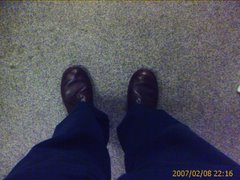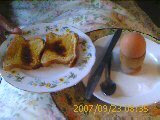Flags in High Places
Many are familiar with the Tibetan Buddhist practice of putting prayer flags at significant sites. This is not just a quaint local custom, but is part and parcel of Buddhist and indeed pre-Buddhist religious activity:
see http://www.prayerflags.com/download/article.pdf
Not only so, but there is a clear promotion of this belief system into western culture - not only through political activist involvement but through seemingly innocent websites for children!
https://shop.theliteracysite.com/store/item.do?itemId=8836&siteId=2001
http://www.atc.org.au/index.php?option=com_content&task=view&id=230&Itemid=89
The Bible talks also of banners - in fact three references in Isaiah talk of them being set up on high places (Isaiah 13:2, 18:3 and 30:17). We must realise however the thinking behind prayer flags in this aspect of Tibetan culture - and not least the source of power invoked is very different as prayerflags.com explains in detail.
As Christian believers, who love the Tibetan people and desire to see them experience God's eternal salvation, how might we respond? What does the bible say about God as 'The Lord our Banner' (Jehovah Nissi)? In Exodus 17 we read that Moses '..built an altar and called it the Lord our Banner' after the defeat of the Amalekites.
The key in this battle was it seems a significant but simple act. The lifting up of the hands of Moses at Rephidim (meaning Rest) over the battle. The battle is decribed in the imperfect tense when it talks about the fighting - ie. it was a repeated action. They seemed to be winning, Moses hands tired, they seemed to be losing, Moses got his hands up again, the battle turned, and so on.
Bearing in mind we are not talking about 10 minutes or half an hour, but clearly hours of fighting, it's hardly surprising an elderly man would get worn out keeping his arms in the air!
So Aaron and Hur came alongside and Moses was supported: he was given a seat and they held up his arms on either side.
So what has this to do with banners and flags? There seems a clear indication that a battle standard in future warfare (take a film like The Patriot (Emmerich,2000) for example) has the role of rallying, encouraging re-grouping, often weary fighters, back to the cause.
Banners are a symbol of rallying, caling together:
He lifts up a banner for the distant nations (Isaiah 5: 26)
In that day the Root of Jesse will stand as a banner for the peoples; the nations will rally to him and his place of rest will be glorious (Isaiah 11:10)
They also have a place in victory and God's overshadowing protection:
We will shout for joy when you are victorious, we will lift up our banners in the name of our God (Psalm 20:5a)
His banner over me is love (Song of Songs 2:4)
Lastly, they help to identify who we are:
The Israelites are to set up their tents by divisions, each man in his own camp under his own standard (Numbers 1:52)
A Prayer:
Lord raise up a banner to the peoples of Tibet, let it be seen in the high places, let it be unfurled against every demonic spirit that binds. The Tibetan ethnic groups are seeking for a salvation that can only be found in you.
Set your banner of them - your covering protection a lover to your beloved, spread your garment over them to include them in your people as Boaz did for Ruth at harvest-time.
Lift up the hands of those who have been travailing, battling and contending for these peoples despite the setbacks. Draw alongside them those who will take over when they weary, support them and encourage them.
We lift up a banner now over the Tibetan peoples and fly the flag of the kingdom over Tibet.
(Homework suggestion: If you have a banner and a map of Tibet, worship the Lord and plant your feet prophetically on that part of the map. Use some of the scriptures above - or others that God gives you - proclaiming 'the Lord is my banner' and 'the Root of Jesse will stand as a banner for the peoples').
All quotations from NIV (1984).
see http://www.prayerflags.com/download/article.pdf
Not only so, but there is a clear promotion of this belief system into western culture - not only through political activist involvement but through seemingly innocent websites for children!
https://shop.theliteracysite.com/store/item.do?itemId=8836&siteId=2001
http://www.atc.org.au/index.php?option=com_content&task=view&id=230&Itemid=89
The Bible talks also of banners - in fact three references in Isaiah talk of them being set up on high places (Isaiah 13:2, 18:3 and 30:17). We must realise however the thinking behind prayer flags in this aspect of Tibetan culture - and not least the source of power invoked is very different as prayerflags.com explains in detail.
As Christian believers, who love the Tibetan people and desire to see them experience God's eternal salvation, how might we respond? What does the bible say about God as 'The Lord our Banner' (Jehovah Nissi)? In Exodus 17 we read that Moses '..built an altar and called it the Lord our Banner' after the defeat of the Amalekites.
The key in this battle was it seems a significant but simple act. The lifting up of the hands of Moses at Rephidim (meaning Rest) over the battle. The battle is decribed in the imperfect tense when it talks about the fighting - ie. it was a repeated action. They seemed to be winning, Moses hands tired, they seemed to be losing, Moses got his hands up again, the battle turned, and so on.
Bearing in mind we are not talking about 10 minutes or half an hour, but clearly hours of fighting, it's hardly surprising an elderly man would get worn out keeping his arms in the air!
So Aaron and Hur came alongside and Moses was supported: he was given a seat and they held up his arms on either side.
So what has this to do with banners and flags? There seems a clear indication that a battle standard in future warfare (take a film like The Patriot (Emmerich,2000) for example) has the role of rallying, encouraging re-grouping, often weary fighters, back to the cause.
Banners are a symbol of rallying, caling together:
He lifts up a banner for the distant nations (Isaiah 5: 26)
In that day the Root of Jesse will stand as a banner for the peoples; the nations will rally to him and his place of rest will be glorious (Isaiah 11:10)
They also have a place in victory and God's overshadowing protection:
We will shout for joy when you are victorious, we will lift up our banners in the name of our God (Psalm 20:5a)
His banner over me is love (Song of Songs 2:4)
Lastly, they help to identify who we are:
The Israelites are to set up their tents by divisions, each man in his own camp under his own standard (Numbers 1:52)
A Prayer:
Lord raise up a banner to the peoples of Tibet, let it be seen in the high places, let it be unfurled against every demonic spirit that binds. The Tibetan ethnic groups are seeking for a salvation that can only be found in you.
Set your banner of them - your covering protection a lover to your beloved, spread your garment over them to include them in your people as Boaz did for Ruth at harvest-time.
Lift up the hands of those who have been travailing, battling and contending for these peoples despite the setbacks. Draw alongside them those who will take over when they weary, support them and encourage them.
We lift up a banner now over the Tibetan peoples and fly the flag of the kingdom over Tibet.
(Homework suggestion: If you have a banner and a map of Tibet, worship the Lord and plant your feet prophetically on that part of the map. Use some of the scriptures above - or others that God gives you - proclaiming 'the Lord is my banner' and 'the Root of Jesse will stand as a banner for the peoples').
All quotations from NIV (1984).









